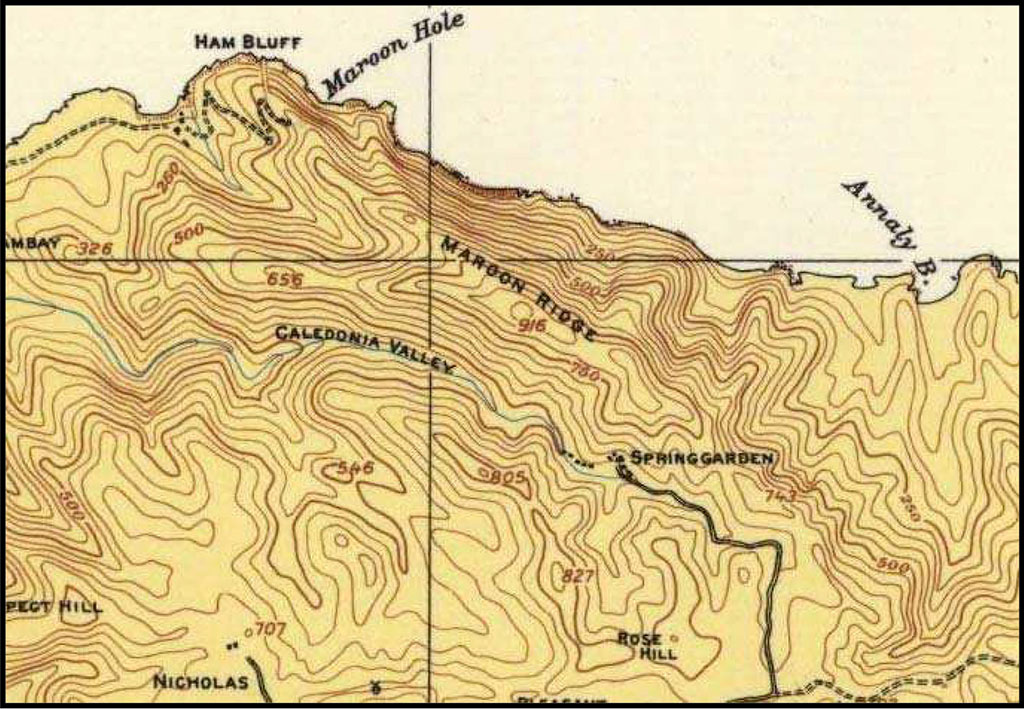
Historical Context
Marronage refers to the act of escaping from slavery and establishing independent communities, often in remote and inaccessible areas. Enslaved Africans on St. Croix, as in other parts of the Caribbean, sought freedom from oppressive conditions by fleeing into the island’s interior or other less accessible regions. The rugged terrain of St. Croix, with its dense forests and mountainous regions, provided ideal cover for these fugitive slaves.
- Petit Marronage: This involved short-term escapes where enslaved individuals would temporarily flee to avoid punishment or harsh working conditions, often returning after a short period.
- Grand Marronage: This was a more permanent form of escape, where individuals or groups would flee to form independent Maroon communities. These were often located in the island’s mountainous or forested regions, which provided natural cover and protection from colonial forces.
St. Croix has a complex colonial history, including periods of Spanish, Dutch, French, Knights of Malta, Danish, and American control. The French period, from 1650 to 1733, and the Danish period from 1733 until emancipation in 1848, were particularly significant in the context of slavery and marronage..
During French, and Danish control, St. Croix’s economy heavily relied on sugar plantations, which were labor-intensive and depended on the forced labor of enslaved Africans. The conditions on these plantations were brutal, with enslaved people facing severe physical punishment, long working hours, and minimal provisions for basic needs.
Maroon Communities on St. Croix
Maroons on St. Croix, as in other parts of the Caribbean, formed communities that were often self-sustaining and fiercely resistant to colonial authorities. These communities were typically located in areas difficult for colonial forces to penetrate, allowing the Maroons a degree of autonomy and safety. They engaged in subsistence agriculture, hunting, and sometimes raiding plantations to acquire supplies.
Resistance and Rebellion
The presence of Maroon communities was a constant source of tension for colonial authorities and plantation owners. Maroons not only represented a loss of labor but also served as a symbol of resistance that could inspire other enslaved people to flee. The colonial response to Maroon communities often involved military expeditions to capture or kill Maroons, but these efforts were not always successful due to the Maroons’ intimate knowledge of the terrain and their guerrilla tactics.
One notable aspect of marronage on St. Croix was its connection to larger revolts and uprisings. Maroon communities sometimes coordinated with enslaved populations still on plantations, providing support and refuge to those who participated in revolts. The collaboration between Maroons and plantation slaves was instrumental in several uprisings that rocked the island.
Legacy of Marronage
The legacy of marronage on St. Croix is a testament to the resilience and resistance of enslaved Africans. These communities were not merely fleeing oppression; they were actively creating new societies and preserving African cultural practices in the face of extreme adversity.
Today, the history of Maroons on St. Croix is celebrated as a crucial part of the island’s heritage. It serves as a powerful reminder of the struggle for freedom and the enduring spirit of resistance among oppressed peoples.
https://www.floridamuseum.ufl.edu/wp-content/uploads/sites/44/2017/04/nortonandespenshade.pdf
https://www.virgin-islands-history.org/en/history/slavery/becoming-a-maroon-and-other-resistance/
note
I had posted about the Save the Hams Bluff lighthouse and also created a page specifically for the lighthouse. While doing research for these, I came across articles written by Olasee Davis, looking to create a Maroon Territorial Park. I don’t know Mr Davis views on the lighthouse, but I wholeheartedly support the creation of a Territorial Park to maintain this important piece of St Croix history.
Part 1: Join the Call for a Maroon Territorial Park
Part 2: St Croix’s Northwest Quarter Worthy of World Heritage Status
https://stcroixsource.com/2022/08/02/open-forum-a-maroon-territorial-park-is-not-an-option-but-a-must/